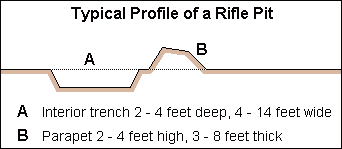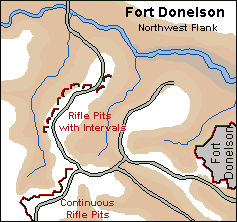Civil War Field Fortifications
Rifle Pits
Within the historical context of the American Civil War
rifle pits were any light field work that combined an interior ditch with
a low parapet that was intended exclusively as cover for infantry. Rifle
pits were distinguished from major works by their low profile which did not
include either a high parapet or an exterior ditch intended that served
as obstacles. Unlike major field works the soil composing the parapet was
usually untamped and the interior slope generally (but not necessarily)
 unrevetted.
This broad category of field fortification may be further subdivided into
two distinct types of works defined by their lateral extent (rather than
their profiles) and functions. Skirmish pits were short detached rifle
pits which provided cover for one, two, or a small group individuals and
were generally were sited in advance and on the flanks of either a fortified
or unfortified position to provide cover for skirmishers or pickets. Rifle
trenches were extended and continuous lines of rifle pits which were
used to connect major field works and cover the front of infantry deployed
in a position. Both types of rifle pits were quite common and often used
in conjunction with each other.
unrevetted.
This broad category of field fortification may be further subdivided into
two distinct types of works defined by their lateral extent (rather than
their profiles) and functions. Skirmish pits were short detached rifle
pits which provided cover for one, two, or a small group individuals and
were generally were sited in advance and on the flanks of either a fortified
or unfortified position to provide cover for skirmishers or pickets. Rifle
trenches were extended and continuous lines of rifle pits which were
used to connect major field works and cover the front of infantry deployed
in a position. Both types of rifle pits were quite common and often used
in conjunction with each other.
As with all field fortifications there were certain advantages
and disadvantages inherent to the fortification form and its use in specific
situations. Rifle pits were relatively simple to construct, required no
engineering expertise, could be thrown up relatively quickly almost anywhere
that a deployed line of infantry happened to stop, and provided fairly efficient
protection against small arms and some artillery fire. Ease and rapidity
of construction made this fortification form (particularly rifle trenches)
a viable alternative to major works in lines of works. Major works in the
defensive line around Vicksburg were connected with continuous low profile
rifle pits that were either constructed in advance of the Confederate army's
occupation of the line or in the hours immediately after its retreat to the
position. The Dimmock Line surrounding Petersburg, Virginia, constructed
in 1863,
also used rifle pits to fortify the intervals between batteries. At
Fort Donelson the Confederate's northwestern flank was covered by a line
of short rifle pits sited at intervals of about 100 yards. Application of
rifle pits to lines of works reduced the amount of time, labor, and expense,
of fortifying a position. In the later stages of the war armies tended to
fortify their positions using rifle trenches and skirmish pits, often without
any pre-laid trace. Skirmish pits, either sited prior to an army's occupation
of a position or by the first pickets sent out to act as an advanced guard,
had the distinct advantage of allowing the pickets to maintain their posts
in positions that would otherwise have been untenably dangerous. These low
profile works also had the supposed advantage of allowing troops to pass
over them with more or less facility to advance to the attack or counterattack
a disordered or retreating enemy.
1863,
also used rifle pits to fortify the intervals between batteries. At
Fort Donelson the Confederate's northwestern flank was covered by a line
of short rifle pits sited at intervals of about 100 yards. Application of
rifle pits to lines of works reduced the amount of time, labor, and expense,
of fortifying a position. In the later stages of the war armies tended to
fortify their positions using rifle trenches and skirmish pits, often without
any pre-laid trace. Skirmish pits, either sited prior to an army's occupation
of a position or by the first pickets sent out to act as an advanced guard,
had the distinct advantage of allowing the pickets to maintain their posts
in positions that would otherwise have been untenably dangerous. These low
profile works also had the supposed advantage of allowing troops to pass
over them with more or less facility to advance to the attack or counterattack
a disordered or retreating enemy.
The primary disadvantage inherent to rifle pits was the
lack of an inclusive obstacle that could slow down an assault and hold an
attacking body of troops under the defenders' fire. Works constructed with
a low profile and without exterior obstacles were vulnerable to being overrun
by unexpected attacks. When both time and means were available rifle pits
were often covered by external obstacles such as palisadings, small pickets,
and abatis. Skirmish pits established in advance of a stronger line tended
to isolate individual pickets, especially during daylight hours, since there
was generally insufficient cover to allow safe movement between picket posts
and back to the main line of works. While advanced skirmish pits allowed
the defenders some measure of warning against an attack, they could also
interfere with defensive fire from the main line of works if their occupants
were slow to retreat to the main line in ahead of an attack.
One of the most important points concerning the study of
field fortifications that needs to be clearly stated is that the specific
fortification form indicated by the use of the terms "rifle pit" or "rifle
pits" can almost never be assumed. These were catch-all phrases that more
often than not were used without any uniform degree of precision. Even though
modern scholarly usage has tended to limit these terms to the definition
of the skirmish pit variation presented here, if one reads source material
with this limitation too firmly fixed, unfortunate errors in understanding
specific fortification forms used in specific cases can occur. Major General
Edward Canby's report of the assault on Fort Blakely, Alabama in April, 1865,
for example, describes the Confederate line of works as consisting of "nine
strong redoubts connected by rifle-pits and palisades." If Canby's "rifle
pits" are understood to mean one or two man holes in the ground, his meaning
will inevitably be badly misconstrued and his description of the form and
implied strength of the Confederate line lost. In this case Canby used the
term in the sense of a rifle trench as defined above. In almost all cases
other evidence exterior to the use of the term, such as a detailed description
of the work itself or an examination of its physical remains, must be brought
to bear to help determine the exact extent of the fortification form referred
to as a rifle pit. Imprecision in the use of the term and its lack of a commonly
recognized definition at the time of the Civil War usually prohibit any general
assumptions concerning the form and extent of any field work described in
source material as a rifle pit.
Also
See the Detailed Note on Rifle Pits
Back to Minor Works
Blockhouses
Batteries
Magazines(Restricted
Access)
Contents
Home Page
Major Works
Permanent Fortifications
Siege Works
Mahan's Principles
Copyright (c) PEMcDuffie 1997, 1998
 unrevetted.
This broad category of field fortification may be further subdivided into
two distinct types of works defined by their lateral extent (rather than
their profiles) and functions. Skirmish pits were short detached rifle
pits which provided cover for one, two, or a small group individuals and
were generally were sited in advance and on the flanks of either a fortified
or unfortified position to provide cover for skirmishers or pickets. Rifle
trenches were extended and continuous lines of rifle pits which were
used to connect major field works and cover the front of infantry deployed
in a position. Both types of rifle pits were quite common and often used
in conjunction with each other.
unrevetted.
This broad category of field fortification may be further subdivided into
two distinct types of works defined by their lateral extent (rather than
their profiles) and functions. Skirmish pits were short detached rifle
pits which provided cover for one, two, or a small group individuals and
were generally were sited in advance and on the flanks of either a fortified
or unfortified position to provide cover for skirmishers or pickets. Rifle
trenches were extended and continuous lines of rifle pits which were
used to connect major field works and cover the front of infantry deployed
in a position. Both types of rifle pits were quite common and often used
in conjunction with each other.
 1863,
also used rifle pits to fortify the intervals between batteries. At
Fort Donelson the Confederate's northwestern flank was covered by a line
of short rifle pits sited at intervals of about 100 yards. Application of
rifle pits to lines of works reduced the amount of time, labor, and expense,
of fortifying a position. In the later stages of the war armies tended to
fortify their positions using rifle trenches and skirmish pits, often without
any pre-laid trace. Skirmish pits, either sited prior to an army's occupation
of a position or by the first pickets sent out to act as an advanced guard,
had the distinct advantage of allowing the pickets to maintain their posts
in positions that would otherwise have been untenably dangerous. These low
profile works also had the supposed advantage of allowing troops to pass
over them with more or less facility to advance to the attack or counterattack
a disordered or retreating enemy.
1863,
also used rifle pits to fortify the intervals between batteries. At
Fort Donelson the Confederate's northwestern flank was covered by a line
of short rifle pits sited at intervals of about 100 yards. Application of
rifle pits to lines of works reduced the amount of time, labor, and expense,
of fortifying a position. In the later stages of the war armies tended to
fortify their positions using rifle trenches and skirmish pits, often without
any pre-laid trace. Skirmish pits, either sited prior to an army's occupation
of a position or by the first pickets sent out to act as an advanced guard,
had the distinct advantage of allowing the pickets to maintain their posts
in positions that would otherwise have been untenably dangerous. These low
profile works also had the supposed advantage of allowing troops to pass
over them with more or less facility to advance to the attack or counterattack
a disordered or retreating enemy.